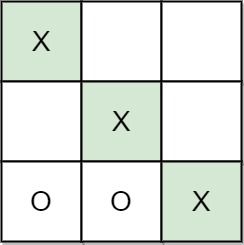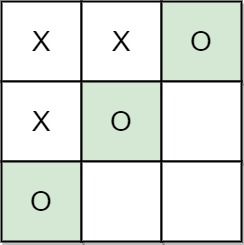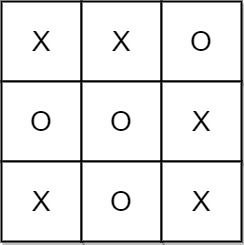| comments | difficulty | edit_url | rating | source | tags | ||||
|---|---|---|---|---|---|---|---|---|---|
true |
Easy |
1336 |
Weekly Contest 165 Q1 |
|
Tic-tac-toe is played by two players A and B on a 3 x 3 grid. The rules of Tic-Tac-Toe are:
- Players take turns placing characters into empty squares
' '. - The first player
Aalways places'X'characters, while the second playerBalways places'O'characters. 'X'and'O'characters are always placed into empty squares, never on filled ones.- The game ends when there are three of the same (non-empty) character filling any row, column, or diagonal.
- The game also ends if all squares are non-empty.
- No more moves can be played if the game is over.
Given a 2D integer array moves where moves[i] = [rowi, coli] indicates that the ith move will be played on grid[rowi][coli]. return the winner of the game if it exists (A or B). In case the game ends in a draw return "Draw". If there are still movements to play return "Pending".
You can assume that moves is valid (i.e., it follows the rules of Tic-Tac-Toe), the grid is initially empty, and A will play first.
Example 1:
Input: moves = [[0,0],[2,0],[1,1],[2,1],[2,2]] Output: "A" Explanation: A wins, they always play first.
Example 2:
Input: moves = [[0,0],[1,1],[0,1],[0,2],[1,0],[2,0]] Output: "B" Explanation: B wins.
Example 3:
Input: moves = [[0,0],[1,1],[2,0],[1,0],[1,2],[2,1],[0,1],[0,2],[2,2]] Output: "Draw" Explanation: The game ends in a draw since there are no moves to make.
Constraints:
1 <= moves.length <= 9moves[i].length == 20 <= rowi, coli <= 2- There are no repeated elements on
moves. movesfollow the rules of tic tac toe.
Since all moves are valid, that is, there is no situation where a person continues to play after someone has won. Therefore, we only need to determine whether the last player to move can win.
We use an array cnt of length
If the last player to move does not win, then we determine whether the board is full. If it is full, it is a draw; otherwise, the game is not over yet.
The time complexity is moves.
class Solution:
def tictactoe(self, moves: List[List[int]]) -> str:
n = len(moves)
cnt = [0] * 8
for k in range(n - 1, -1, -2):
i, j = moves[k]
cnt[i] += 1
cnt[j + 3] += 1
if i == j:
cnt[6] += 1
if i + j == 2:
cnt[7] += 1
if any(v == 3 for v in cnt):
return "B" if k & 1 else "A"
return "Draw" if n == 9 else "Pending"class Solution {
public String tictactoe(int[][] moves) {
int n = moves.length;
int[] cnt = new int[8];
for (int k = n - 1; k >= 0; k -= 2) {
int i = moves[k][0], j = moves[k][1];
cnt[i]++;
cnt[j + 3]++;
if (i == j) {
cnt[6]++;
}
if (i + j == 2) {
cnt[7]++;
}
if (cnt[i] == 3 || cnt[j + 3] == 3 || cnt[6] == 3 || cnt[7] == 3) {
return k % 2 == 0 ? "A" : "B";
}
}
return n == 9 ? "Draw" : "Pending";
}
}class Solution {
public:
string tictactoe(vector<vector<int>>& moves) {
int n = moves.size();
int cnt[8]{};
for (int k = n - 1; k >= 0; k -= 2) {
int i = moves[k][0], j = moves[k][1];
cnt[i]++;
cnt[j + 3]++;
if (i == j) {
cnt[6]++;
}
if (i + j == 2) {
cnt[7]++;
}
if (cnt[i] == 3 || cnt[j + 3] == 3 || cnt[6] == 3 || cnt[7] == 3) {
return k % 2 == 0 ? "A" : "B";
}
}
return n == 9 ? "Draw" : "Pending";
}
};func tictactoe(moves [][]int) string {
n := len(moves)
cnt := [8]int{}
for k := n - 1; k >= 0; k -= 2 {
i, j := moves[k][0], moves[k][1]
cnt[i]++
cnt[j+3]++
if i == j {
cnt[6]++
}
if i+j == 2 {
cnt[7]++
}
if cnt[i] == 3 || cnt[j+3] == 3 || cnt[6] == 3 || cnt[7] == 3 {
if k%2 == 0 {
return "A"
}
return "B"
}
}
if n == 9 {
return "Draw"
}
return "Pending"
}function tictactoe(moves: number[][]): string {
const n = moves.length;
const cnt = new Array(8).fill(0);
for (let k = n - 1; k >= 0; k -= 2) {
const [i, j] = moves[k];
cnt[i]++;
cnt[j + 3]++;
if (i == j) {
cnt[6]++;
}
if (i + j == 2) {
cnt[7]++;
}
if (cnt[i] == 3 || cnt[j + 3] == 3 || cnt[6] == 3 || cnt[7] == 3) {
return k % 2 == 0 ? 'A' : 'B';
}
}
return n == 9 ? 'Draw' : 'Pending';
}

